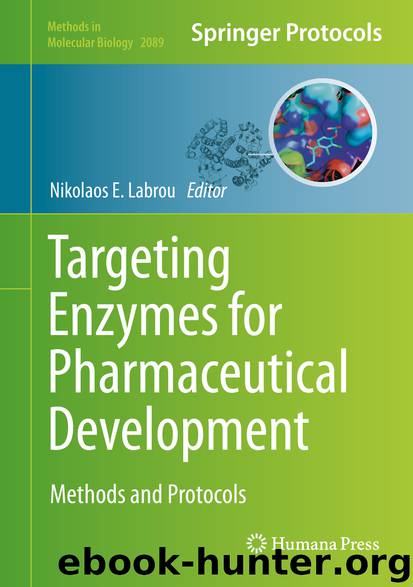Targeting Enzymes for Pharmaceutical Development by Unknown

Author:Unknown
Language: eng
Format: epub
ISBN: 9781071601631
Publisher: Springer US
3.4 Regeneration of Sensor Surface for the Multiple Round of Analyses Using SPR
1.The regeneration reagent in principle should not only facilitate in removing the previously bound gD protein from the HVEM but also make sure that the HVEM binding affinity should retain the binding affinity to the gD protein. If these two conditions are achieved, it reduces using multiple sensor chips for the analyses and further reduces the time required for screening as well as the cost (scheme in Fig. 5a).
2.To evaluate whether the 0.1% SDS regeneration solution affect the HVEM binding to gD protein, two cycles of analysis of HVEM-gD interactions and regeneration of sensor surface are performed (similar to scheme shown in Fig. 5a). For this, the above used HVEM immobilized sensor chip is explored as described: Inject 100 μL of 100 nM of gD of HSV-1 (in binding buffer) with a flow rate of 30 μL/min for 7 min at 25 °C and observe a sensogram response (Fig. 6a). To remove gD protein from the HVEM surface, as described above, inject regeneration solution with a flow rate of 10 μL/min for 2 min at 25 °C followed by washing with binding buffer for 1 min with a flow rate of 30 μL/min at 25 °C. Next, to test whether the HVEM surface retained the same affinity after the treatment with regeneration solution, the binding analyses is repeated by injecting the same amount (100 nM) of gD of HSV-1 (in binding buffer) over the regenerated surface with a flow rate of 30 μL/min for 7 min at 25 °C. The resulting sensogram response signal was observed (Fig. 6b). For direct comparison, the two analyzed sensogram responses were overlaid, i.e., before and after the treatment with regenerating solution and found that the sensogram responses were identical, suggesting that the HVEM binding activity toward gD protein was not altered the HVEM surface by the regeneration solution. Further, we repeated the same process for more than 20 times and found no significant effect on HVEM binding ability to the gD protein. However, in the control flow cell 1 do not show any response signal, suggesting that gD protein does not bind to the flow cell surface (blank surface without HVEM).
Download
This site does not store any files on its server. We only index and link to content provided by other sites. Please contact the content providers to delete copyright contents if any and email us, we'll remove relevant links or contents immediately.
Life 3.0: Being Human in the Age of Artificial Intelligence by Tegmark Max(4509)
The Sports Rules Book by Human Kinetics(3588)
ACT Math For Dummies by Zegarelli Mark(3565)
The Age of Surveillance Capitalism by Shoshana Zuboff(3423)
Blood, Sweat, and Pixels by Jason Schreier(3130)
Unlabel: Selling You Without Selling Out by Marc Ecko(2981)
Urban Outlaw by Magnus Walker(2950)
Hidden Persuasion: 33 psychological influence techniques in advertising by Marc Andrews & Matthijs van Leeuwen & Rick van Baaren(2778)
The Pixar Touch by David A. Price(2740)
Bad Pharma by Ben Goldacre(2730)
Project Animal Farm: An Accidental Journey into the Secret World of Farming and the Truth About Our Food by Sonia Faruqi(2661)
Brotopia by Emily Chang(2592)
The Content Trap by Bharat Anand(2493)
Slugfest by Reed Tucker(2417)
The Airbnb Story by Leigh Gallagher(2371)
Kitchen confidential by Anthony Bourdain(2306)
Coffee for One by KJ Fallon(2008)
Smuggler's Cove: Exotic Cocktails, Rum, and the Cult of Tiki by Martin Cate & Rebecca Cate(1979)
Beer is proof God loves us by Charles W. Bamforth(1921)
